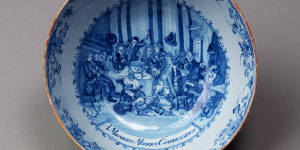
Detail from ‘A Midnight Modern Conversation’ by William Hogarth (1732). Wikimedia Commons.
Research Questions
-
The participation of the V&A in the project provides the necessary expertise with which to consider the production and distribution of objects and artefacts, and the ways in which they informed the consumption of intoxicants in this period of economic and social change.
-
One set of questions concern the economics of material life: the changing distribution of pewter, glass, earthenware, and silver over the course of the period; the inter-penetration of materials and designs between continental Europe and England; and the appropriation of products by different social groups.
-
Another considers the material dimensions of social practice: the extent to which the size, form, and use of vessels was connected to, and perhaps helped constitute, different modes of social practice over time.
-
A third area of interest is the manner in which the material culture of intoxication communicated ideologies (e.g. partisan or nationalistic) and served as a focus for different kinds of ‘society’.
Find out more about this theme and our methodology in our probate inventories blog post…

Sources
Digitised artefacts held in museum collections will be categorised according to materials, size, type, and inscription. These objects offer clues about the economy and aesthetics of drinking, and complement the textual and visual evidence from other strands. Probate inventories also offer invaluable information about the trade in and consumption of different kinds of goods, certainly where commercial consumption is concerned. Data can be matched with equivalent objects in museum collections, giving shape to the former and placing the latter in their social contexts. An initial survey suggests that the most effective way of tracing the social distribution of intoxicants and their material culture is to focus on retailers, producers, and licensed sellers.
